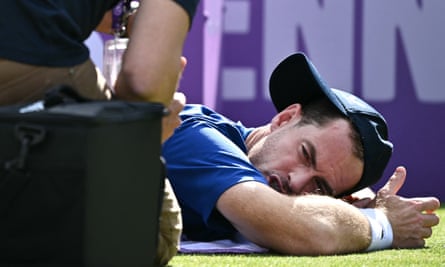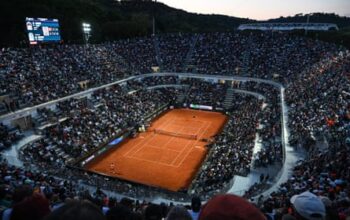On the eve of the Queen’s Club championship nearly two weeks ago, Andy Murray was announced as part of the Great Britain Olympic team for the fifth time in his career. The Olympics have become, in a way, Murray’s one stronghold at the top of professional tennis. He remains the only player in the Open era to win two singles gold medals, which is more than Novak Djokovic, Rafael Nadal and Roger Federer combined.
During his press conference that day, Murray was asked about his success in the Olympics and what his medals have meant to his career. He discussed London 2012 at the All England Club, a narrative-shifting triumph that proved an essential step towards his three grand slam wins, and also his epic repeat at Rio 2016. But Murray spent almost as much time discussing his heartbreaks, from his excruciating cramps in his first round singles loss at Beijing 2008 to his misery in 2021, where he and Joe Salisbury came so close to a men’s doubles medal in Tokyo.
It was a perfect reflection of Murray’s career. He has won so much and achieved so many accolades in the sport, placing himself among the greats, but much of his success has come after suffering and struggle and he has had to fight so hard for everything he has achieved. Even for Murray himself, it is impossible to discuss his victories without mentioning his struggles.
In the final stretch of Murray’s career, he has one more brutal setback to contend with as he races to be fit in time for Wimbledon after undergoing back surgery last Saturday following his retirement from his second-round match at Queen’s.
Although Murray was initially told by doctors that his recovery could be six to 12 weeks and he had no chance of competing at Wimbledon, since then, consultations have been more promising and rehab has been positive. He may train for the first time on site at Wimbledon from Saturday.
If he makes it on to the singles court, Murray would face Tomas Machac of the Czech Republic in the first round. With every hour important in his recovery, the Scot was helpfully drawn into the opposite half of the draw to Carlos Alcaraz, who as the men’s defending champion will open the championship on Monday. Murray v Machac is therefore scheduled for Tuesday.
Along with singles, Murray has also entered the doubles draw with Jamie Murray, which would be his first time competing with his brother at Wimbledon. After spending their formative years battling each other on the courts of Dunblane and dreaming of SW19, Andy and Jamie converted their dreams to incredible success, with the pair reaching No 1 in singles and doubles respectively. Even if Murray is unable to take to the court for singles, closing out his Wimbledon career alongside his brother in doubles, a shorter and much less physically demanding format, would still be a sentimental ending.

This is far from Murray’s first time being locked in a dramatic race against time to be fit for a major tournament. Uncertainty and last-minute decisions have been a staple of his career, particularly since his hip issues began in 2017. He withdrew two days before the 2017 US Open. At Wimbledon 2018, a day after stating that he was ready to go, he withdrew on the eve of the tournament. There have also been so many instances where he has come with an injury and endured significant pain yet he still managed to piece together another deep run.
Even if he does manage to compete, doing so with this preparation will still be an extremely difficult way for Murray to close such an incredible chapter at Wimbledon, but it is also fitting. So many players in this position, faced with another horrible setback ,would have understandably reached their limit and thrown in the towel.
Instead, Murray’s last stand is another show of his fortitude. This year has already been so tough, with difficult results in the first three months of the season followed by torn ankle ligaments in his Miami Open match against Machac just as he seemed to be regaining his form. It took six hard weeks of rehab for him to make it back from that, only for a new injury to strike shortly afterwards. Still, he remains defiant.
“If there was no chance of me being able to play Wimbledon, which I thought was going to be the case a week ago when I’d had my initial consultations and stuff – I was told that this was going to be six to 12 weeks – I wouldn’t be sitting here today just waiting until the last minute to have my name in the draw.
“I’m trying everything I can to play, I’m practising on the court, I’m rehabbing and trying to accelerate this process to give myself a chance to play. And yeah I don’t feel guilty about it,” said Murray on Thursday.
Over the years, many great players have burned bright before eventually losing focus or desire, no longer willing to devote so much of their lives to such a single-minded cause.
It is incredible that despite his setbacks, Murray’s love for tennis and competition has never dimmed. He has been sustained and satisfied for so long by the daily work of improving, being disciplined and pushing himself to his outer limits in service of his goals.
And so here he is, working desperately through more painful and miserable days of injury rehabilitation even though the stakes have changed so much. For much of his career, Murray was motivated by trying to catch the greatest players in history and win grand slam titles. Now he simply wishes to be on court and to be competitive one more time. His desire and will is the same.
As things stand, everything is up in the air and it is possible that Murray will never play a singles match at Wimbledon again. No matter how he fares, perhaps this is how he should be remembered; a player who fought until the bitter end, regardless of his circumstances.
He was determined when he was the best player in the world sweeping up significant titles, but even when his hip turned to metal, the rest of his body gradually crumbled and the sport seemed to be conspiring against him, he never stopped striving to become the best tennis player he could be.


